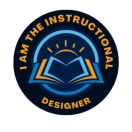
I am the Instructional Designer
Frequently Asked Questions
What services do you provide?
I provide complete instructional design services, including AI-enhanced eLearning development, scenario-based training, gamification, simulations, microlearning, and multimedia production. I also support content strategy, evaluation, and LMS deployment.
Do you use AI tools in your development process?
Yes. AI is integrated throughout my workflow for content creation, scenario design, rapid prototyping, visual generation, voiceover development, and quality assurance. This improves efficiency and enhances learner engagement.
What industries have you worked with?
I have developed training for corporate, government, security, healthcare, technology, higher education, and professional services environments.
What tools and technologies do you use?
My toolkit includes Storyline, Rise, Vyond, Camtasia, CenarioVR, Canva, Adobe Creative Suite, and a range of generative AI tools. I also work with SCORM, xAPI, and LMS platforms such as Workday, Cornerstone, and Moodle.
Do you create custom eLearning courses?
Yes. All courses are custom-designed and aligned with your organization’s goals, audience needs, policies, and branding. I produce interactive, mobile-responsive, and fully accessible experiences.
Can you build gamified learning experiences?
Yes. I design structured gamification systems such as challenges, branching missions, badges, leaderboards, timers, and decision-based outcomes that support measurable learning objectives.
Do you work with small businesses or individual instructors?
Yes. I collaborate with entrepreneurs, small training teams, academic instructors, and independent professionals to develop targeted, high-quality learning solutions.
Are you available for full-time or contract work?
Yes. I am available for full-time roles, contract engagements, ongoing retainer support, or project-based consulting depending on the organization’s needs.
Can you assist with LMS setup and integration?
Yes. I prepare SCORM/xAPI packages, assessment structures, course organization, and reporting frameworks to ensure smooth deployment across major LMS platforms.
Do you offer free resources?
Yes. I provide free instructional design downloads and free music resources on my website.
